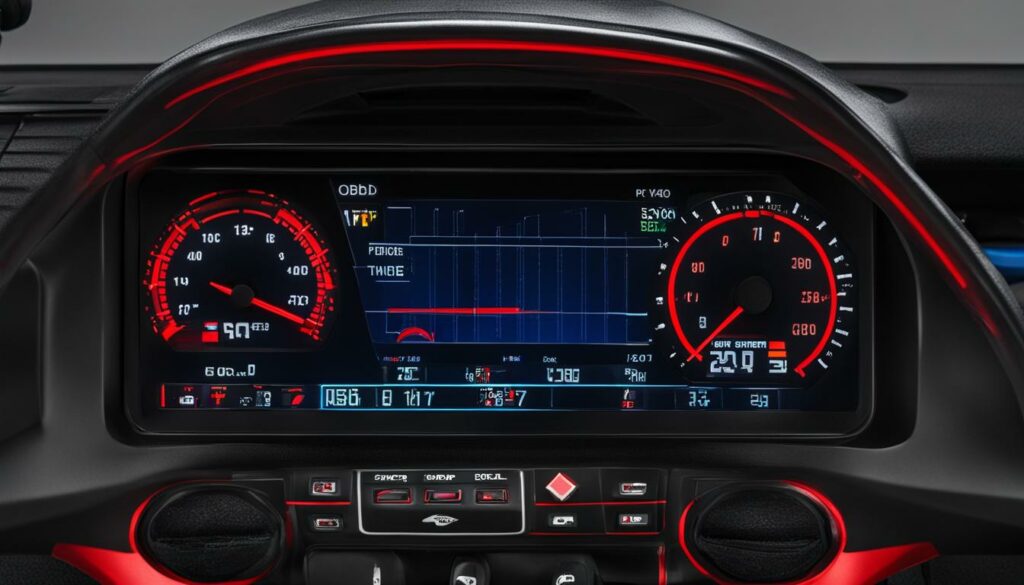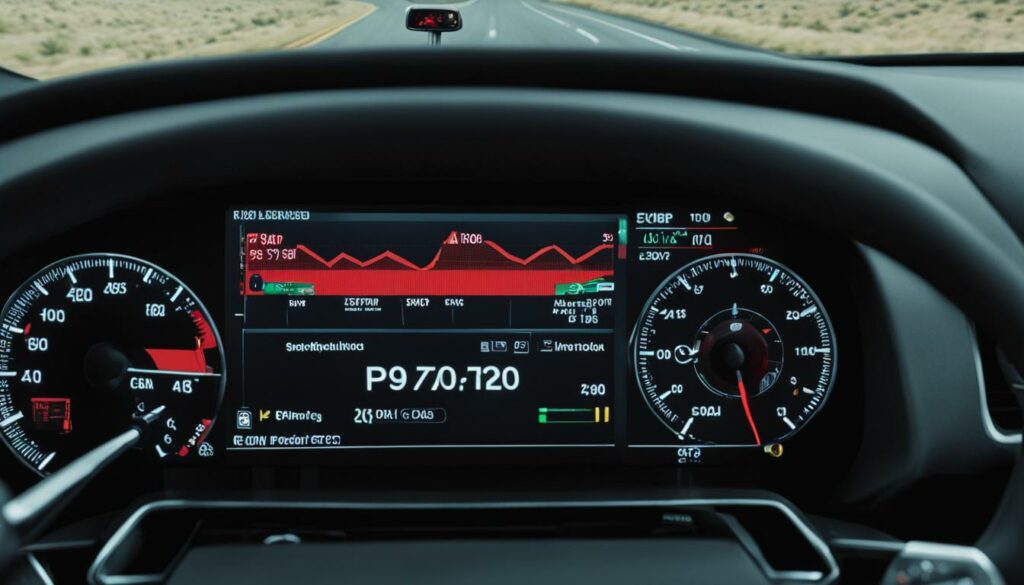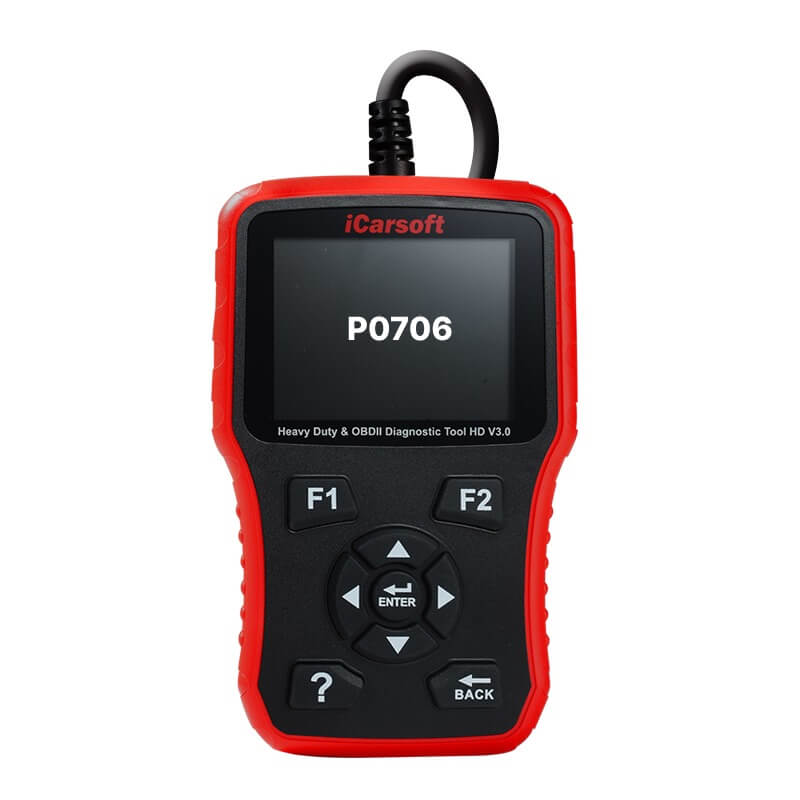P0706 – Transmission Range Sensor Circuit Range/Performance
POSTED IN pcodes
The P0706 code is a common issue that affects vehicles with automatic transmissions. It indicates a problem with the transmission range sensor circuit, which is responsible for detecting the position of the gear selector lever and communicating that information to the engine control module (ECM). When the sensor fails to provide accurate data, the P0706 code is triggered.
In this article, we will explore the causes, symptoms, diagnosis, and repairs associated with the P0706 code. By understanding these key aspects, you will be better equipped to address the issue and ensure the optimal performance of your vehicle.
But first, let’s take a closer look at the transmission range sensor and its role in the circuit range/performance:
Key Takeaways:
- The P0706 code indicates a problem with the transmission range sensor circuit.
- The transmission range sensor detects the position of the gear selector lever.
- Incorrect data from the sensor triggers the P0706 code.
- Symptoms may include poor shifting, decreased acceleration, and the vehicle going into “limp” mode.
- Thorough diagnosis by a qualified mechanic is crucial to accurately identify the root cause.
What Causes the P0706 Code?
When the P0706 code appears, there are several potential causes that could be contributing to the issue. These causes include:
- Dirty or poor quality transmission fluid
- A damaged or defective park/neutral position switch (also known as the transmission range sensor)
- Improperly adjusted park/neutral position switch
- Damage or faulty wiring to the transmission range sensor
- A damaged or defective valve body
- Faulty manual shift valve linkage
- Shorted or open park/neutral position switch harness
- A bad electrical connection to the park/neutral position switch circuit
- A damaged or defective control cable
- In rare cases, a damaged or defective ECM (engine control module)
It is important to consider these potential causes when diagnosing and addressing the P0706 code in order to resolve the issue effectively.
Buy tested tuning file for Adblue / EGR / DPF / Adblue off now!
What are the Symptoms of the P0706 Code?
The P0706 code can manifest through several symptoms, indicating potential issues with the transmission. It is crucial to be aware of these symptoms to address them promptly and prevent further damage. Here are some common indications that you may encounter if your vehicle has a P0706 code:
- Check Engine Light (CEL) Illumination: The first noticeable symptom of a P0706 code is the illumination of the Check Engine Light on the dashboard. This serves as an early warning sign that there is a problem with the transmission range sensor circuit.
- Poor Shifting Performance: Another symptom is experiencing poor shifting performance. You may notice that the transmission shifts harshly, takes longer to shift, or struggles to find the appropriate gear. This can make driving uncomfortable and affect the overall performance of your vehicle.
- Decreased Acceleration: A P0706 code can lead to a decrease in acceleration. Your vehicle may feel sluggish and struggle to reach higher speeds. This can be a safety concern, especially in situations that require immediate acceleration.
- Inability to Switch Gears: When the transmission range sensor circuit malfunctions, it can result in the inability to switch gears smoothly. You may find it difficult to shift into different gears or experience resistance when trying to engage a specific gear.
- Poor Fuel Efficiency: Another symptom associated with the P0706 code is poor fuel efficiency. If the transmission range sensor is not functioning correctly, it can impact the overall performance of the transmission system and lead to increased fuel consumption.
- Limp Mode: In more severe cases, your vehicle may go into “limp” mode. Limp mode is a safeguard feature that reduces engine power and restricts transmission operation to prevent further damage. This mode is activated when a critical issue is detected in the transmission system.
Experiencing any of these symptoms is a clear indication that your vehicle requires attention. Ignoring these signs may lead to more severe transmission issues and costly repairs. It is essential to consult with a qualified mechanic or technician to diagnose and resolve the P0706 code and its associated symptoms.
“Experiencing any of these symptoms is a clear indication that your vehicle requires attention. Ignoring these signs may lead to more severe transmission issues and costly repairs.”
How Does a Mechanic Diagnose the P0706 Code?
A mechanic can diagnose a P0706 code using various methods and tools to ensure an accurate assessment of the issue. The following steps outline the diagnostic process:
- OBD-II Scanner: The mechanic will utilize an OBD-II scanner to retrieve the stored trouble code (P0706). This scanner allows them to access valuable diagnostic information from the vehicle’s onboard computer system.
- Visual Inspection: Next, the mechanic will visually inspect the range sensor and the wiring harness for any visible signs of damage or wear. This visual inspection helps identify any potential issues that may be causing the P0706 code.
- Test Drive: To further diagnose the problem, the mechanic may perform a test drive to observe the vehicle’s behavior. They will pay close attention to how the transmission performs during acceleration, shifting, and deceleration. This test drive can provide additional insights into the underlying issue.
- Circuits Continuity and Resistance: The mechanic will also check for circuits continuity and resistance to ensure the proper functioning of the transmission range sensor and related components. By measuring the electrical resistance and establishing continuity across the circuits, they can identify any potential electrical faults or anomalies.
Following these diagnostic steps, the mechanic will have a better understanding of the root cause of the P0706 code. This information will enable them to proceed with the necessary repairs to resolve the issue effectively.

Common Mistakes when Diagnosing the P0706 Code
When dealing with a P0706 code, it is crucial to avoid common mistakes during the diagnostic process. Failure to do so can lead to misdiagnosis and unnecessary repairs. Two common errors to watch out for are overlooking the possibility of an engine misfire or driveline problem as the root cause of the code, and neglecting to check for any other stored codes that could provide essential clues. By avoiding these mistakes and following thorough diagnostic procedures, mechanics can accurately identify the underlying issue.
Engine Misfire: A Potential Culprit
One of the common mistakes made when diagnosing a P0706 code is disregarding the possibility of an engine misfire. An engine misfire can trigger the code since it can affect the transmission’s performance. Ignoring this potential cause can lead to a misdiagnosis and unnecessary replacement of transmission components. It is essential to thoroughly inspect the engine for any signs of misfire, such as rough idle, lack of power, or abnormal engine noise.
Driveline Problems: Consider All Possibilities
Another common mistake is failing to consider driveline problems as a potential cause of the P0706 code. Driveline issues, such as a faulty driveshaft, damaged CV joints, or worn-out differential components, can affect the transmission’s ability to operate correctly. These problems can mimic the symptoms associated with a faulty transmission range sensor, leading to an incorrect diagnosis. Mechanics should carefully inspect the driveline components and assess their condition before jumping to conclusions.
Check for Other Stored Codes
The P0706 code may not be the only code stored in the vehicle’s computer system. Other related codes, such as transmission range sensor circuit performance codes (e.g., P0705, P0707, P0708, P0709), can provide valuable information about the root cause of the problem. It is essential to perform a comprehensive scan of all stored codes to gain a complete picture of the vehicle’s issues. Neglecting to check for other stored codes may result in overlooking crucial diagnostic clues.
By avoiding these common mistakes and conducting a thorough diagnosis, mechanics can effectively identify the true cause of the P0706 code. This ensures that the correct repairs are performed, saving time, money, and unnecessary part replacements.
| Mistake | Consequence |
|---|---|
| Overlooking engine misfire | Potential misdiagnosis and unnecessary transmission repairs |
| Neglecting driveline problems | Incorrect diagnosis and unnecessary transmission repairs |
| Failure to check for other stored codes | Missing vital diagnostic clues |
How Serious is the P0706 Code?
The P0706 code is considered potentially serious as it can have a significant impact on the vehicle’s operation. When this code is triggered, it indicates a problem with the transmission range sensor circuit. One of the immediate effects is that the transmission may go into what is known as “limp” mode.
Limp mode is a protective measure that the transmission takes when it detects a fault. In this mode, the transmission limits its functionality to prevent further damage. While in limp mode, the vehicle may experience reduced power, poor performance, and issues with shifting. These symptoms can affect safety, drivability, and overall vehicle operation.
It is crucial to address the P0706 code promptly by having the vehicle diagnosed and repaired by a professional technician. Ignoring this code or delaying repairs can lead to further complications and potential damage to the transmission system.
“When the transmission goes into ‘limp’ mode, the vehicle’s performance is compromised, and it may not operate as expected. This can create unsafe driving conditions and should be addressed immediately.”
By addressing the P0706 code promptly, you can ensure that the transmission operates properly, with normal shifting, acceleration, and power delivery. This, in turn, helps maintain the overall performance and reliability of your vehicle.
To give you a better understanding of the seriousness of the P0706 code, here is a table summarizing its impact on vehicle operation:
| Symptoms | Impact on Vehicle Operation |
|---|---|
| Poor shifting | Affects the vehicle’s ability to change gears smoothly, potentially leading to unsafe driving conditions. |
| Decreased acceleration | Reduces the vehicle’s ability to accelerate, affecting performance and responsiveness. |
| Inability to switch gears | Limits the vehicle’s maneuverability, potentially leaving it stuck in a specific gear. |
| Poor fuel efficiency | Increases fuel consumption due to inefficient transmission operation. |
| Limp mode | Reduces power and performance to protect the transmission from further damage. |
Given the impact on vehicle operation, it is strongly recommended to have the P0706 code addressed promptly to ensure safe and reliable vehicle performance.

What Repairs can Fix the P0706 Code?
Several repairs can address the P0706 code. These may include:
- Flushing and filling the transmission fluid if it is dirty
- Repairing or replacing any damaged or faulty wiring or connectors
- Checking battery voltage levels
- Repairing or replacing any damaged or defective circuits or connectors
- Repairing or replacing the transmission range sensors
- In rare cases, replacing a damaged or defective ECM
After performing the necessary repairs, it is important to clear all codes, test drive the vehicle, and rescan to ensure that the code does not reappear.
Conclusion
In conclusion, the P0706 code points to a potential issue with the transmission range sensor circuit. It is crucial to take immediate action to prevent further damage to the transmission and maintain optimal vehicle performance.
For an accurate diagnosis, it is recommended to consult a qualified mechanic who can conduct a thorough evaluation and identify the root cause of the problem. Once the cause is determined, appropriate repairs can be implemented to resolve the issue.
Regular vehicle maintenance plays a vital role in preventing codes like P0706. Checking the transmission fluid regularly and addressing any warning lights or abnormal symptoms can help identify problems early on and minimize the risk of encountering transmission-related issues.
Remember, a well-maintained vehicle ensures smooth operation and extends the lifespan of your transmission. By prioritizing vehicle maintenance and promptly addressing any diagnostic codes, you can enjoy a trouble-free driving experience.
FAQ
What causes the P0706 code?
The P0706 code can be caused by several factors, including dirty or poor quality transmission fluid, a damaged or defective park/neutral position switch, improperly adjusted park/neutral position switch, damaged or faulty wiring to the transmission range sensor, a damaged or defective valve body, faulty manual shift valve linkage, shorted or open park/neutral position switch harness, a bad electrical connection to the park/neutral position switch circuit, a damaged or defective control cable, or in rare cases, a damaged or defective ECM.
What are the symptoms of the P0706 code?
The symptoms of a P0706 code may include the illumination of the Check Engine Light, poor shifting performance, decreased acceleration, inability to switch gears, poor fuel efficiency, and the vehicle going into “limp” mode. “Limp” mode refers to a reduced power mode that the transmission enters to protect itself from further damage.
How does a mechanic diagnose the P0706 code?
A mechanic can diagnose a P0706 code through several methods. They will typically use an OBD-II scanner to check for the stored trouble code and may perform a visual inspection of the range sensor and wiring harness for any signs of damage. They may also perform a test drive to see if the code reappears and check for circuits continuity and resistance to ensure proper functioning of the transmission range sensor and related components.
What are common mistakes when diagnosing the P0706 code?
One common mistake is overlooking the possibility of an engine misfire or driveline problem that may be causing the code. It is crucial to check for any other stored codes that could be the ultimate cause of the problem before replacing parts unnecessarily. Thorough diagnostic procedures should be followed to accurately identify the root cause of the P0706 code.
How serious is the P0706 code?
The P0706 code is considered potentially serious due to the potential impact on the vehicle’s operation. The transmission may go into “limp” mode, resulting in reduced power and poor performance. Additionally, the vehicle may experience poor shifting, decreased acceleration, and other issues that can affect safety and drivability. It is recommended to have the vehicle diagnosed and repaired by a professional as soon as possible to avoid further complications.
What repairs can fix the P0706 code?
Several repairs can address the P0706 code. These may include flushing and filling the transmission fluid if it is dirty, repairing or replacing any damaged or faulty wiring or connectors, checking battery voltage levels, repairing or replacing any damaged or defective circuits or connectors, repairing or replacing the transmission range sensors, or in rare cases, replacing a damaged or defective ECM. After performing the necessary repairs, it is important to clear all codes, test drive the vehicle, and rescan to ensure that the code does not reappear.
Conclusion
The P0706 code indicates a problem with the transmission range sensor circuit. It is important to address this issue promptly to prevent further damage to the transmission and ensure proper vehicle operation. A thorough diagnosis by a qualified mechanic is essential to accurately identify the root cause of the code. Once the cause is determined, appropriate repairs can be made to resolve the issue. Regular vehicle maintenance, including checking transmission fluid and addressing any warning lights, can help prevent codes like P0706 from occurring.


